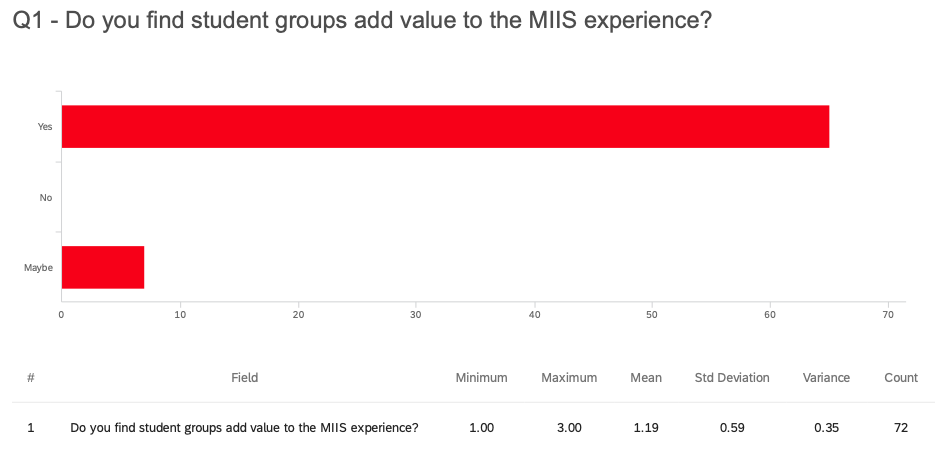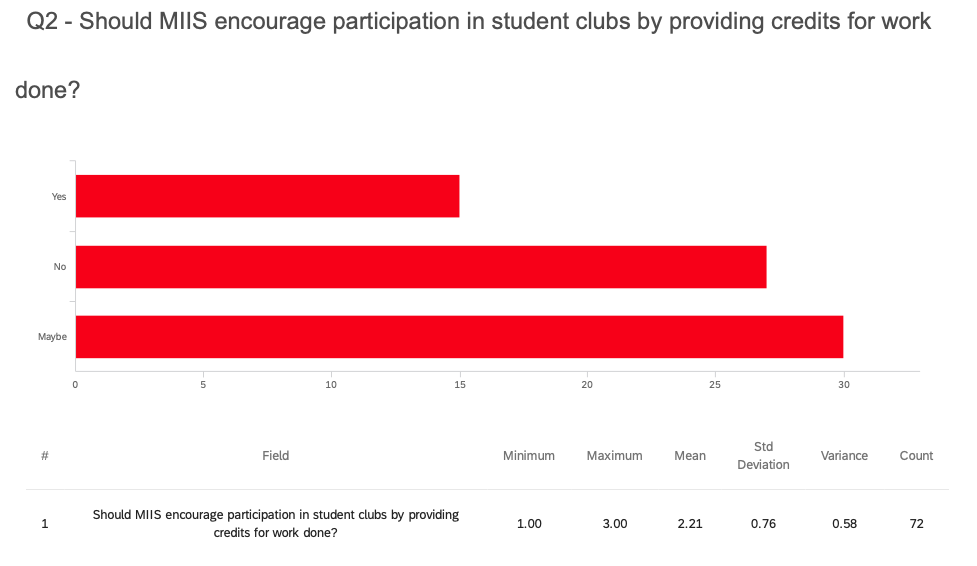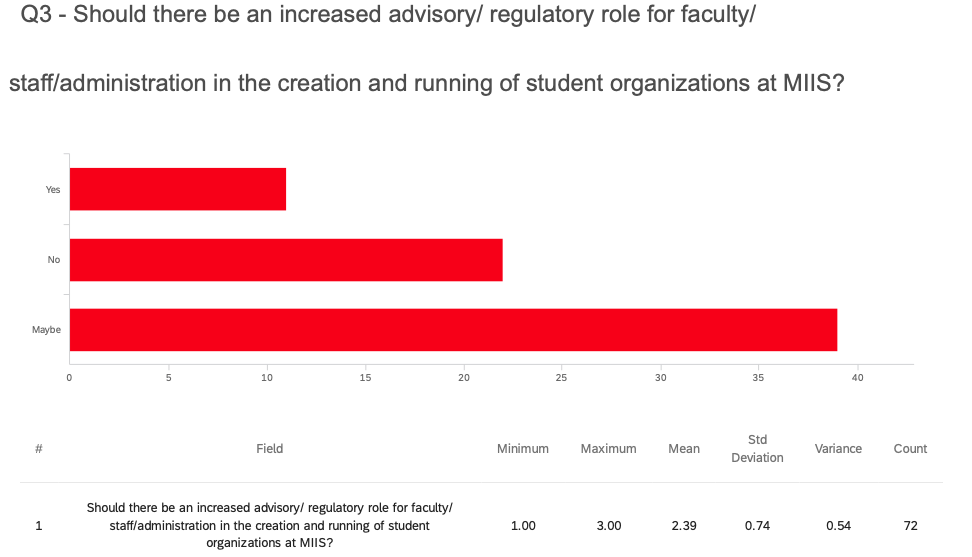By Pushpa Iyer with Jason Buchanan
We received 72 responses from our most recent poll on student organizations and thanks to those of you who participated. No matter the number of responses, it is always interesting to see what people think, especially given our current context.
Please also take the time to participate in our next survey, which is looking into the future of The Black Mirror newsletter. We welcome your input, and because we would like to engage with some of you personally, we will require your emails to respond to the survey.
Click here for the survey.

Once again, a reminder that these poll results are not intended to reflect a representative sample and are not linked to any policy decisions. We ask you to consider the results as a source for conversation and discussion on campus. We hope you continue to participate in future polls and always remember to adhere to polite communication rules that support our values at MIIS.
The topic for our last poll was focused on student organizations and their role and impact at MIIS.
The first question in the poll was: “Do you find student groups add value to the MIIS experience?” An overwhelming majority (90.28%) answered affirmatively. Only 9.72% answered “Unsure.”

Consensus on the second question was less clear. When asked, “Should MIIS encourage participation in student clubs by providing credits for work done?” most seemed uncertain (41.67%). 20.83% answered, “Yes,” and 37.5% answered, “No.”

Opinions were similarly mixed on the third question: “Should there be an increased advisory/regulatory role for faculty/staff in the creation and running of student organizations?” The majority (54.17%) were unsure. Only 15.28% answered “Yes,” with the remaining 30.56% of respondents answering “No.”

In addition to the poll results, we also identified three major themes from the comments respondents submitted. These themes coincided largely with the questions we asked in our poll.
Student organizations serve various student needs.
Not surprisingly, most commenters agreed that student-run organizations promoted student involvement in critical issues both within and outside of campus, mainly because they could set their own pace for their work based on student interests. Many also felt that student organizations helped students who were seeking a social or professional group to meet their identity needs. A few people commented that student organizations at MIIS helped students learn and join professional networks, something that MIIS, as an institution, could do better through its advising center. Student organizations at MIIS also seemed to meet the need for building a strong community. There are usually no barriers to joining student groups at MIIS, including identity-based groups, and this is especially true for international and other students who were seeking to make friends in a new environment. There was also a sense that at MIIS, these organizations offered an opportunity for students to make friends outside of their program, and many students seemed to welcome the opportunity to connect with “new” people.
Respondents also agreed that each student group’s individualized aims and goals provided a variety of opportunities to students. “Some are more active, participatory, collaborative than others.” Because of this, it may be difficult to compare them to one another; however, one thing is clear for one respondent: “Without student organizations, MIIS would be less spirited, creative, and interesting.”
The responses received reaffirm what many others have said about the role that student organizations play in the life of a student on campus. In her thesis, Ayesha Hawkins’ findings reaffirm the positive role that student organizations play in furthering retention and persistence in community colleges. The responses we received did not stress how student organizations contributed to student wellbeing but rather building community. This alludes to mental health benefits of belonging to a group. Laura Horne, in fact, advocates for higher education institutions to partner with student organizations to address campus mental health because, as she says, students know best what they need. At MIIS, we have made some strides in this direction by creating space in the student council for a health and wellness director.
More faculty/staff/student collaboration in student groups.
The responsibility to maintain student groups should fall on the students themselves. According to multiple respondents: “It’s up to us [students] to take our activism/involvement in the direction we’re passionate about.” Although most seemed to agree that groups should remain student-led, respondents could also see the value of increased collaboration and partnership with faculty and staff. Commenters offered a variety of ways in which this collaboration could take shape. “There may be some benefit in working closely with CACS to help students make choices about club participation and leadership and then leverage those activities in their job search and career,” suggested one commenter. Another said they would like to see more faculty/student collaboration in developing external partnerships. Close faculty/staff involvement in student organizations could also help promote sustainability. As one reader put it: “Given that some programs are accelerated, and students are only here for two semesters, there is space for faculty/staff/admin to be more involved in student groups. This isn’t an undergrad residential college where students have more time to participate in such things. I think time and opportunities are wasted by assuming students will get things up and running quickly.” Involving faculty and staff from the onset might ensure buy-in year to year and maximize a group’s impact, they felt. A quick survey of procedures to set up student organizations shows that faculty/ staff advisors to student organizations are required by most educational institutions and the reason for this varies from sustainability of student organizations to help create professional networks. There is also the added benefit of faculty and staff getting to know students outside of the classroom and thus provide more specific advice on personal and career development. Marjorie K Nadler discusses the positive impact of greater student-faculty collaborations when it comes to providing hands-on experiences through student organizations.
Students should not receive credits for work through student organizations.
Although many respondents were unsure whether students should receive credits for their work through student organizations, very few said they should receive credits for participation or work. Most of the comments centered around how stressful student organization work would become if one were seeking credits. One respondent said, “They [student organizations] are valuable, but part of their value is from community building. It’s hard to create that environment if you’re being graded on how much fun you’re having or being monitored by a superior.” There was also the fear that if one were graded, student organizations would resemble a class structure. Others raised questions as to whether receiving credits for student groups would affect tuition. The logistics would become complicated and, therefore, best not to offer credits, said many. There was also a sense among some students (they did identify themselves as students when responding) that not everything that students did on campus should be tied to their academic success. All this said, this particular master’s thesis examined Bok’s framework for evaluating core competencies students gained through participation in student organizations. Although statistically the study proved that there was no significant growth in student knowledge, skills or competencies through participation in student organizations, it highlighted the importance of having such a framework when developing specific competencies to align with the purpose of those student organizations Even if not receiving credits, these kinds of evaluations might help both faculty and staff advisors in highlighting the overall growth of a student in the institution.
Once again, thank you for your participation in this poll. To participate in the next survey on future directions of The Black Mirror, click here.


